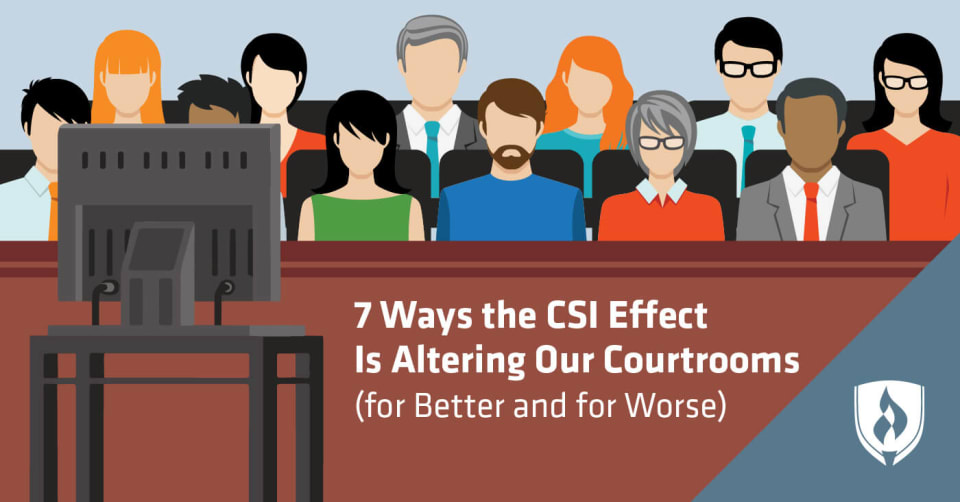7 Ways the CSI Effect is Altering Our Courtrooms (For Better and For Worse)
By Kristina Ericksen on 01/25/2017

We’ve all been there: sitting on the edge of our seat, popcorn in hand, completely caught up in the latest crime drama unfolding before us on our television screen.
A greedy son murders his parents to get his hands on their life insurance payout. Newly discovered DNA evidence is used to crack an unsolved mystery from decades ago. No matter how many times we see similar storylines unfold, we can’t help but be enthralled.
Scroll through your local listings and you’ll notice the breadth of crime shows on TV these days. This speaks volumes to the mass interest and curiosity of the criminal justice system amongst the general public.
Between the dramatized “true crime” shows and the straight up fictionalized programs, there’s no shortage of crime and legal programming in our lives. This is causing many legal professionals to notice the lines blurring between real life circumstances and Hollywood’s portrayal of it. It’s called the CSI effect and it’s changing modern day courtrooms.
What is the CSI effect?
The term was coined after the long-running television show, CSI: Crime Scene Investigation. The CSI effect is prosecutors’ belief that crime programs are skewing jurors’ courtroom expectations, ultimately making it more difficult to win their cases and convict defendants.
Naysayers question the existence of the CSI effect, or they think it’s just part of a bigger problem. Some believe technology in general is the real culprit. Yet the belief is persistent—CSI and other crime programs are seeping into our courtrooms and influencing jurors.
The concept doesn’t seem to be too much of a stretch, considering CSI was once deemed the most watched show in the world and has entertained millions of viewers since it first aired in 2000. And studies suggest that regular CSI viewers hold higher expectations for courtroom evidence than non-viewers. Other studies have revealed CSI viewers are also likely to frequently watch other law-related TV shows.
The media is saturated with programming centering on crime and law. But what effect does this TV crime consumption have in our real-life courtrooms? Keep reading to learn about seven ways it’s changing the game, for better and for worse.
Negative effects of the CSI effect
1. It’s become more difficult to prosecute defendants
Today’s jurors want more hard evidence. They want the smoking gun and the DNA proof—the unmistakable proof that points to the perpetrator. But any legal professional will tell you this doesn’t always exist.
Some think this is why high-profile defendants like Casey Anthony and Robert Blake were acquitted in recent years. Circumstantial evidence and even eye-witness accounts don’t cut it in the shadow of the high-tech, flashy world of CSI and other shows. 21st century jurors are expecting sophisticated science to be included in every trial—even though it may not always reflect the reality of the case.
2. It’s become harder to find jurors
In light of the CSI effect, some states now allow lawyers to dismiss potential jurors from the pool based on the TV programs they watch. Lawyers may flag and remove jurors that enjoy their weekly dose of CSI and other crime programs. This is starting to limit the pool of potential candidates to serve in criminal court cases.
3. It’s straining already tight resources
To feed jurors’ appetites for bulletproof forensic evidence, some investigators have started to run seemingly useless tests simply to garner more evidence to bolster their case and appease the jury members. These tests add more strain to already-tight budgets in death investigations across the US.
4. It’s manipulating crime scenes
Criminals have access to the same television programming as the rest of us. Some believe the surplus in crime shows is changing their behavior as well. While these programs are not always entirely true, many of the proceedings are based upon facts.
Criminals are taking notes and becoming more skilled at covering their tracks. They know to wear gloves to avoid leaving fingerprints, and they know to use bleach to clean up incriminating evidence.
5. Defense lawyers are spending too much time educating juries
While all may seem well for the defendant in the age of the CSI effect, it’s not exactly the case. Defense teams must meticulously present and explain DNA and other forensic evidence to juries—defining what is to be expected and what exists solely on the silver screen.
Juries also have difficulty understanding forensic evidence, like DNA, which is calculated in probabilities rather than certainties. As a result, defense teams often waste valuable time throughout the trial ensuring jurors’ expectations and understandings are clear.
Positive effects of the CSI effect
6. Jurors are becoming more knowledgeable
While CSI-viewers tend to have higher expectations for scientific evidence in trials, they also show patterns of superior legal knowledge compared to their non-CSI-watching counterparts. One survey indicated that CSI viewers were more likely to expect evidence relevant to a specific crime than non-CSI viewers. They also knew what type of evidence would be irrelevant to specific crimes.
However, more knowledgeable jurors isn’t always a good thing. Jurors may think they are more knowledgeable on forensic evidence than they truly are. They may be aware of forensic testing and its capabilities but not understand when it is appropriately used in a case.
7. Interest is increasing in the criminal justice field
If nothing else, crime shows are at least raising interest and awareness of the legal, medical and investigative professionals and what they do. Bringing the work of these often-overlooked criminal justice professionals to the public eye is introducing individuals to potential professional opportunities in the field.
What can be done?
It’s highly unlikely that Americans’ obsession with crime shows will diminish anytime soon. So what can be done to minimize the negative impact of the CSI effect? Should law enforcement agencies commit to overhauling resources and equip investigative teams with the highest possible forensic technology? Or does the problem lay within our crime laboratories—should more responsibility be placed on them to keep up with the demands and reduce analysis backlog?
Perhaps the issue is in the courtroom. Should judges address unrealistic juror expectations? Should legal teams rethink how they explain and present evidence to juries? No matter which changes take hold, the greater legal system needs to prioritize adjusting to the evolving expectations of jurors.
Curious about careers?
Next time you sit down to enjoy your favorite crime show, keep in mind that not everything you see—even the so-called “real cases”—reflect reality.
RELATED ARTICLES:




